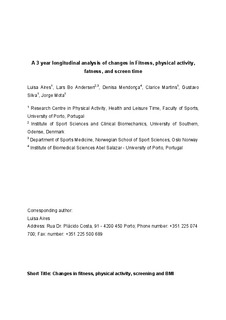| dc.contributor.author | Aires, Luisa | |
| dc.contributor.author | Andersen, Lars Bo | |
| dc.contributor.author | Mendonca, D. | |
| dc.contributor.author | Martins, C. | |
| dc.contributor.author | Silva, G. | |
| dc.contributor.author | Mota, Jorge | |
| dc.date.accessioned | 2010-10-04T13:24:04Z | |
| dc.date.available | 2010-10-04T13:24:04Z | |
| dc.date.issued | 2009-10-19 | |
| dc.identifier | Seksjon for idrettsmedisinske fag / Department of Sports Medicine | |
| dc.identifier.citation | Acta Paediatrica. 2010, 99(1), 140-144 | en_US |
| dc.identifier.issn | 0803-5253 | |
| dc.identifier.uri | http://hdl.handle.net/11250/170645 | |
| dc.description | I Brage finner du siste tekst-versjon av artikkelen, og den kan inneholde ubetydelige forskjeller fra forlagets pdf-versjon. Forlagets pdf-versjon finner du på www.wiley.com: http://dx.doi.org/10.1111/j.1651-2227.2009.01536.x / In Brage you'll find the final text version of the article, and it may contain insignificant differences from the journal's pdf version. The definite version is available at www.wiley.com: http://dx.doi.org/10.1111/j.1651-2227.2009.01536.x | en_US |
| dc.description.abstract | Aim: To analyse whether changes in physical activity index (PAI), screen time (ST: television, computer) and body mass index (BMI) made a contribution to longitudinal changes in fitness of children and adolescents. Additionally, we analysed the interaction between baseline fitness level and changes in fitness.
Methods: This is a 3-year longitudinal study of 345 high school students aged 11–19 years. Students performed curl-ups, push-ups and 20-m shuttle run tests from Fitnessgram. PA and ST were evaluated using a standard questionnaire. Standardized scores of fitness tests were summed. Changes over time were calculated as Δ1 (2007 minus 2006), Δ2 (2008 minus 2007) and Δ3 (2008 minus 2006).
Results: Changes in PAI were positively and independently associated with changes in fitness in Δ1, Δ2 and Δ3. Changes in BMI were negatively associated with changes in fitness in Δ3. Participants highly fit at baseline were those who showed positive changes in PAI over Δ3, decreased changes in ST and had the lowest increase in BMI over 3 years compared with those low-fit at baseline.
Conclusions: Changes in BMI were associated with changes in fitness over 3 years. However, changes in PAI were the best predictor for changes in fitness in each year and over the 3 years of evaluation in youth. | en_US |
| dc.language.iso | eng | en_US |
| dc.publisher | Wiley | en_US |
| dc.subject | BMI | en_US |
| dc.subject | habitual physical activity | en_US |
| dc.subject | physical fitness | en_US |
| dc.subject | sedentary time | en_US |
| dc.subject | youth | en_US |
| dc.title | A 3-year longitudinal analysis of changes in fitness, physical activity, fatness and screen time | en_US |
| dc.type | Journal article | en_US |
| dc.type | Peer reviewed | en_US |
| dc.subject.nsi | VDP::Medical disciplines: 700 | en_US |
| dc.source.pagenumber | 140-144 | en_US |
